10+ Best Substitutes for Tomato Puree
When you buy through our links, The Breslin may earn an affiliate commission. Learn more
How many good tomato puree substitutes can you think of? For many people, the answer would be 3,4, or 5 at the very best.
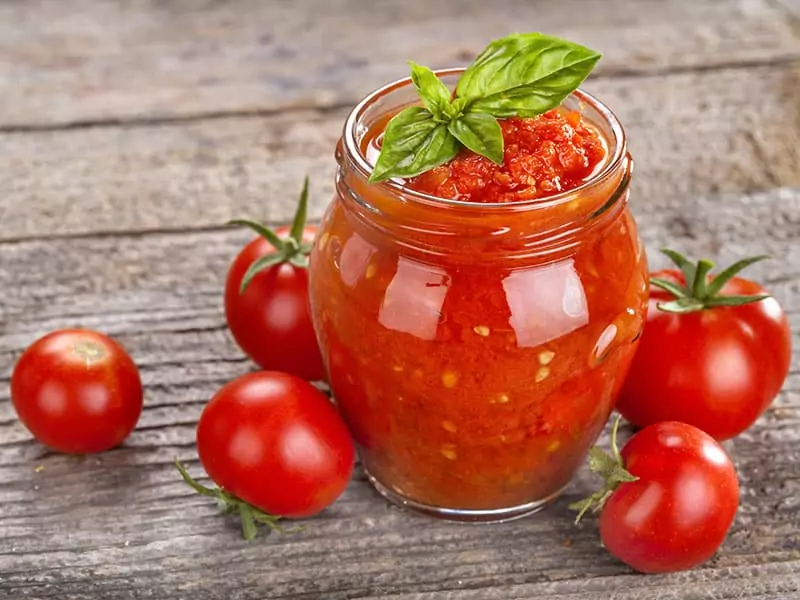
Well, be ready to be pleasantly surprised as there are actually more than 10 viable choices for your tomato puree alternatives. In this article, I’ll go through all of them so that you’ll know exactly what to do the next time your tomato puree runs out.
Tomato Puree – A Crucial Ingredient For Delicious Dishes
Tomato puree is a type of sauce made by straining and cooking tomatoes. In the U.S, it’s a prepackaged food product and often sold in canned form.
In terms of consistency and taste, tomato puree is the in-between of tomato sauce and tomato paste. Although It’s not as thick and sweet as a paste, it’s denser and has a more refined taste than a sauce.(1)
Tomato puree is used as a base ingredient for many sauces and dips, especially in Italian dishes. A pizza or creamy tomato pasta sauce can’t be completed without some spoonfuls of tomato puree!
In addition, tomato puree is also used as an alternative to real tomatoes to add an extra kick of sweet and sour flavor. This is particularly useful in any dishes that favor the smooth, sauce-like texture of tomato puree over the chunky feeling of chopped tomatoes.
For A Quick Solution, Don’t Miss This Table
If you’re too eager for a quick answer, here’s a table that summarizes all the viable substitutes and their respective ratio.
| Substitutes | Substitutes Ratio |
| Tomato paste | 1 cup of tomato puree = ⅓ cup of tomato paste + ⅔ cups of water or ½ cup of tomato puree = ¼ cup of tomato paste + ¼ cup of water |
| Tomato sauce | 1 cup of tomato puree = 1 cup of tomato sauce |
| Ketchup | 1 cup of tomato puree = 1 cup of ketchup |
| Pizza sauce | 1 cup of tomato puree = 1 cup of pizza sauce |
| Marinara sauce | 1 cup of tomato puree = 1 cup of marinara sauce |
| Passata | 1 cup of tomato puree = 1 cup of thinned out passata |
| Diced Tomatoes | 1 cup of tomato puree = 2 cups of diced tomatoes |
| Blended roasted tomatoes | 1 cup of tomato puree = 1 cup of blended roasted tomatoes |
| Fish Sauce Or Worcestershire | Adjust accordingly to taste, water down first |
| Vegemite | 1 cup of tomato puree = 1 cup of vegemite |
| Pumpkin Or Squash Puree | 2 cups of tomato puree = 1 cup of pumpkin or squash puree |
The Best Options For Tomato Puree Substitute
To better understand how these ingredients are suitable to replace your tasty tomato puree, give this section a read.
1. Tomato Paste
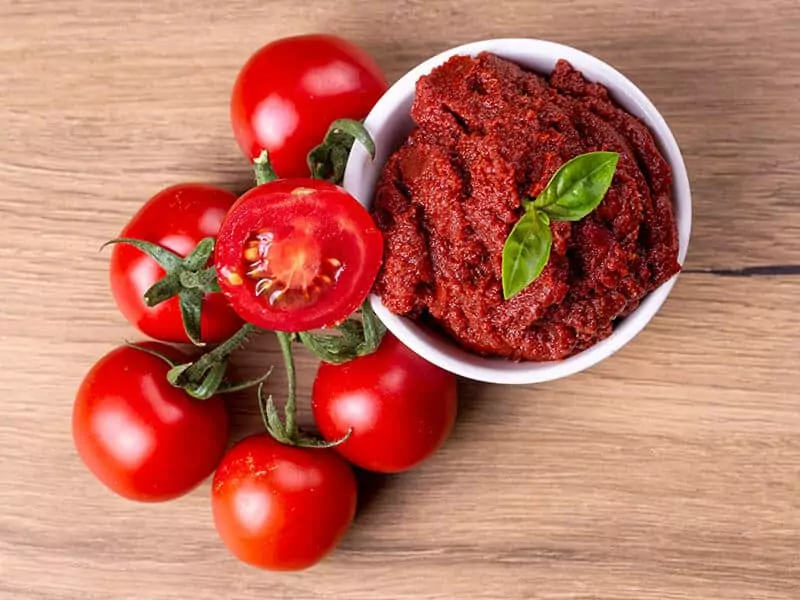
You can think of tomato paste as a thicker and sweeter version of tomato paste. Thanks to this, it will work just fine as a tomato puree alternative. However, due to its denser nature, you’ll need to thin out the consistency a little bit.
To do this, simply mix ⅓ cup of tomato paste with ⅔ cups of water together. This will reduce the texture and consistency of tomato paste to that of a puree. After that, use 1 cup of this mixture for 1 cup of tomato puree.
Another way to turn tomato paste into a tomato puree replacement is by mixing the same amount of water and paste together. You can use a mixture of ¼ cup of tomato paste and ¼ cup of water for half a cup of tomato puree.
When mixed with an appropriate amount of water, tomato paste provides a good alternative for the puree in liquid recipes such as soups, sauces, stews, and casseroles.
However, since the paste has a more concentrated flavor than the puree, it’s best to keep the seasoning and spices to a minimum when using them as a replacement.
2. Tomato Sauce
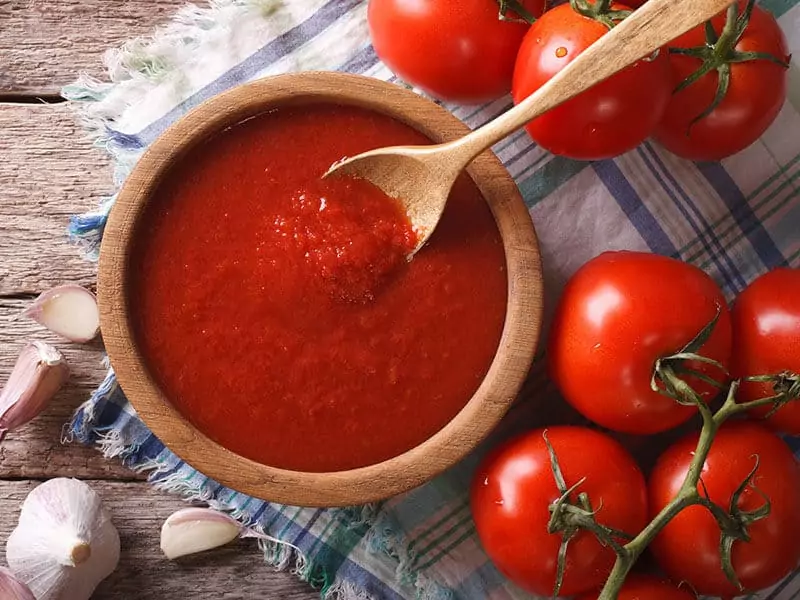
Contrary to the paste, tomato sauce is often considered a thinner tomato puree. However, what it lacks in thickness, it makes up for in flavorful seasoning. Moreover, you can easily thicken tomato sauce by cooking it on a stove until it has lost some of the liquid content.
Keep in mind that tomato sauce can be seasoned with extra spices, herbs, garlic, onions, basil, and oregano. This is why it’s better to tone down the seasoning when cooking with tomato sauce in place of tomato puree.
With just a little attention to the seasoning, you have a perfect tomato puree substitute that’s suitable for every recipe.
You can replace tomato puree with tomato sauce in a 1:1 ratio.
3. Ketchup
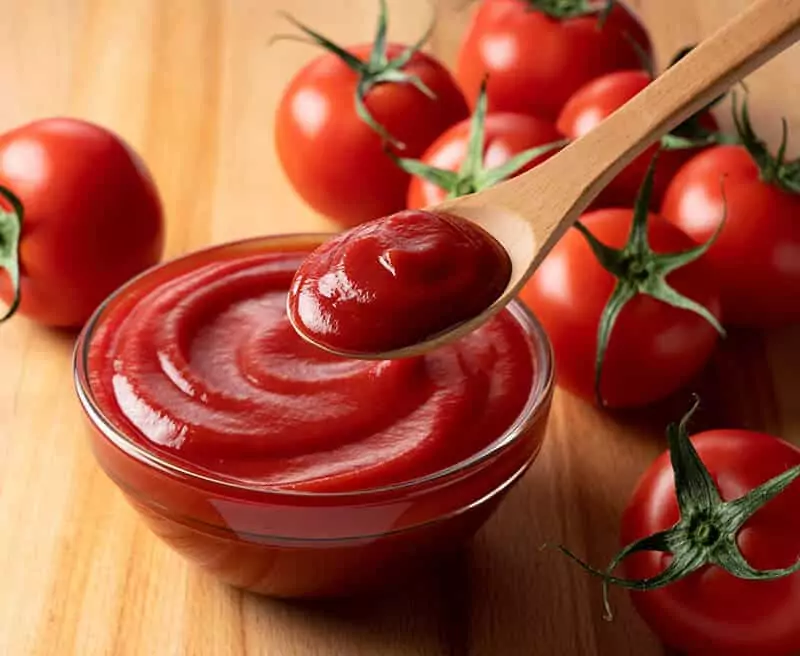
Some people absolutely despise using ketchup as a tomato puree alternative because of its flavor. While ketchup still retains the tangy taste of tomatoes, it can be a bit (and sometimes quite a lot) sweeter than the tomato puree.
Now, before you start screaming in protest, hear me out first.
Although the taste of ketchup can indeed be a little overbearing compared to that of a puree, it can also work as a substitute if you’re really in dire need.
For ketchup, you can also use the 1:1 ratio. However, you should only use it for dishes where the tomato puree acts as the cherry on top rather than one of the main ingredients.
4. Pizza Sauce
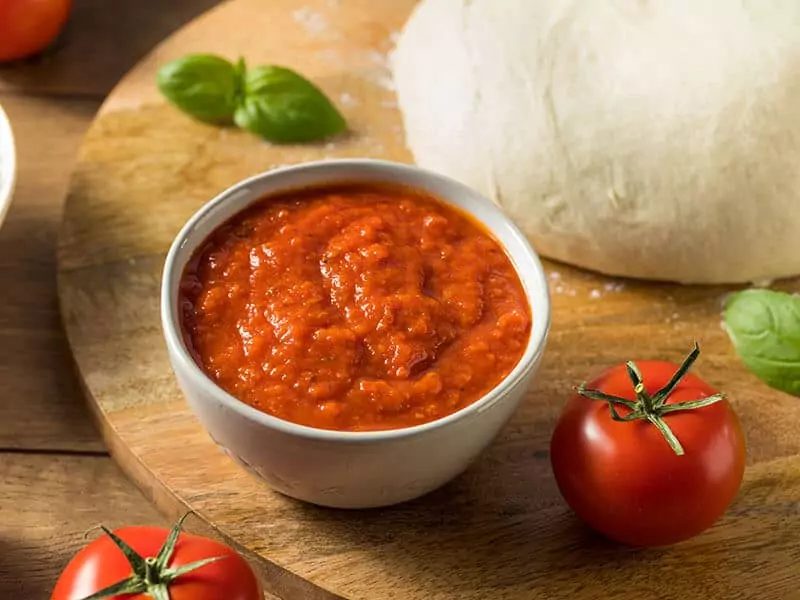
Remember when I told you that tomato puree is used as a base ingredient for many sauces? Well, pizza sauce is one of them, so it’s no big surprise that you can use it to substitute for the lack of puree.
Pizza sauce has quite a thick consistency with a flavor that contains both the refreshing feel of tomatoes and a hint of minty taste from oregano. All in all, most people enjoy pizza sauce, so as long as you are good with the more seasoned taste of it, it’s a solid option for a tomato puree alternative.
Pizza sauce fits well in a variety of recipes that make good uses of tomato puree. You can use it in straight-forward dishes such as pies, burritos, burgers, or add it in soups, grilling, or dipping sauces recipes in place of the puree.
When cooking with pizza sauce, use the same amount of sauce that you normally would with tomato puree.
Pizza sauce is easy to make at home, and here’s how.
5. Marinara Sauce
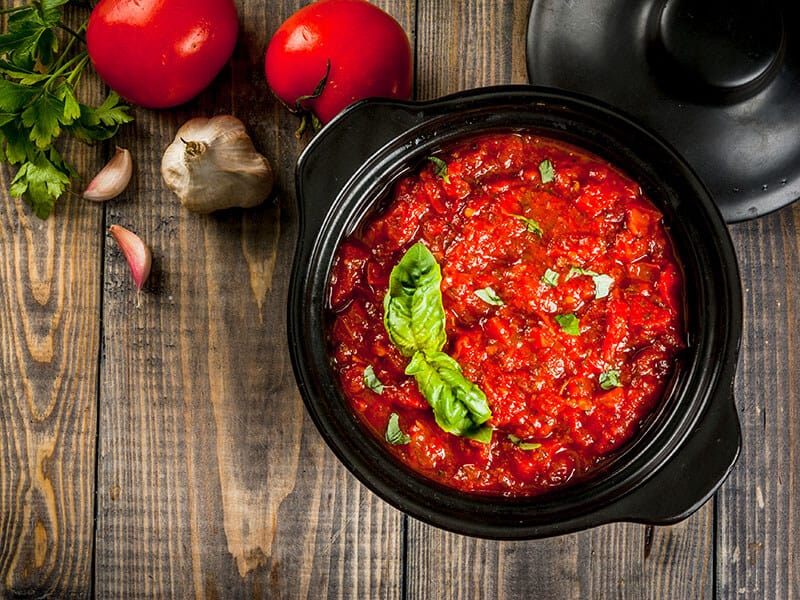
Marinara sauce is quite similar to pizza sauce in the sense that it’s also a crowd-pleasing condiment with a fresh tomato flavor that’s quite similar to the tomato puree. So if you enjoy the taste, there’s no reason not to give it a try.
Keep in mind that marinara sauce is typically a fairly simple sauce and not as complex tasting as, say, tomato sauce. So make sure to change up the seasoning if needed.
Other than that, feel free to use it the way you would use pizza sauce as a tomato puree alternative.
You can substitute marinara sauce with tomato puree in a 1 to 1 fashion.
No need to go out of your way to buy marinara sauce since you can make it at home easily.
6. Passata
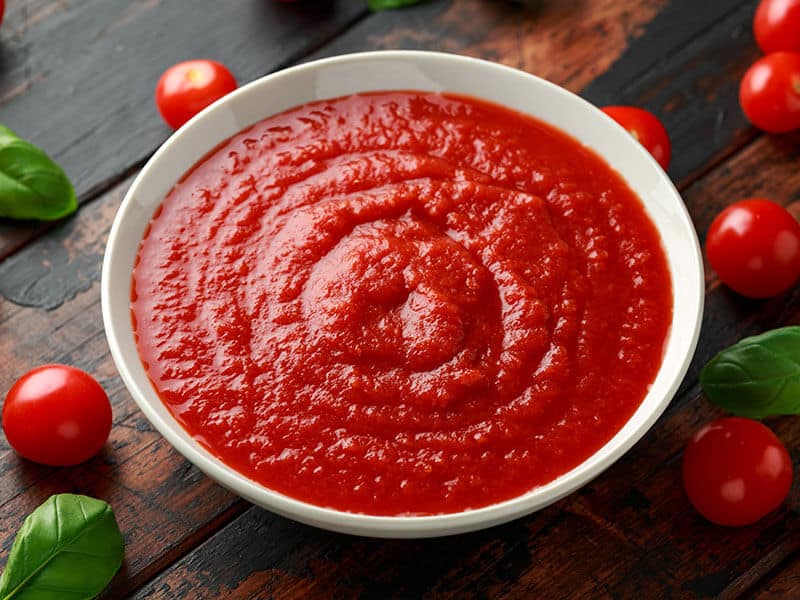
If you speak Italian, you probably know that passata literally means puree in this language. However, the U.S and Italian versions of tomato puree are slightly different from each other.
In the Italian version, the tomatoes are often kept raw when pureed, and the final result comes out a little bit thicker. Tomato puree in America, on the other hand, is made from cooked and skinned tomatoes.
In other words, passata is crushed and pureed raw tomatoes in a can, which explains why it has a strong tomato flavor and a particularly thick consistency. Passata shines best when used in soups or pasta recipes that don’t require a cooking time of more than 30 minutes.
As these two are basically the same thing (with a small difference in their consistency), passata is a perfect replacement for tomato puree. However, because passata is slightly denser, you might need to add some water to thin it out a little.
After that, feel free to use it as a 1 to 1 alternative.
7. Canned Tomatoes
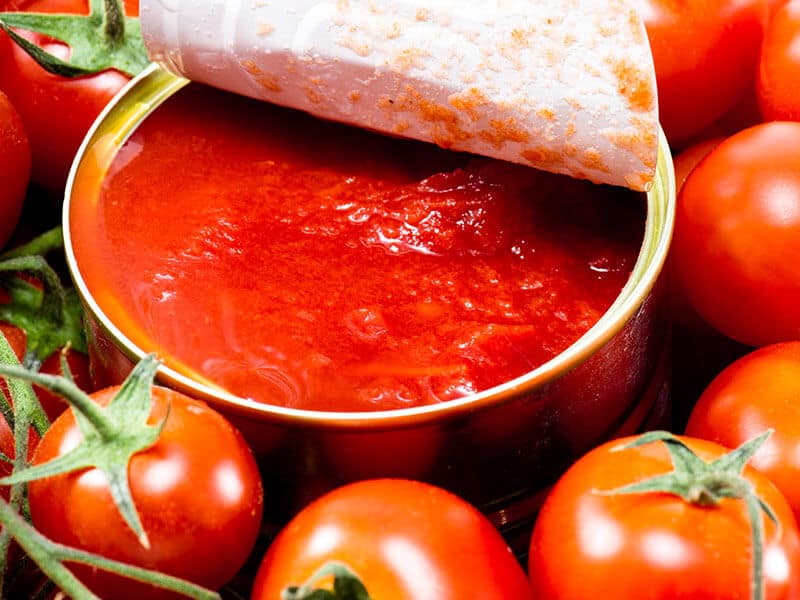
Canned tomatoes are widely available and have a similar taste to the tomato puree. By using a blender or a food processor to remove the excess liquid, you can turn chunky canned tomatoes into a smooth, creamy puree in no time.
Well-made canned tomatoes are sweet with a slight trace of acidity in taste; however, they can taste quite rough and watery when uncooked. To keep the flavor closest to that of a tomato puree, avoid adding any additional spices or seasoning.
Canned tomatoes can be used in a wide variety of dishes ranging from pizza, pasta, salsa, soup to risotto, skillets, or casserole.
For canned tomatoes, you can simply use the 1:1 ratio.
8. Diced Tomatoes
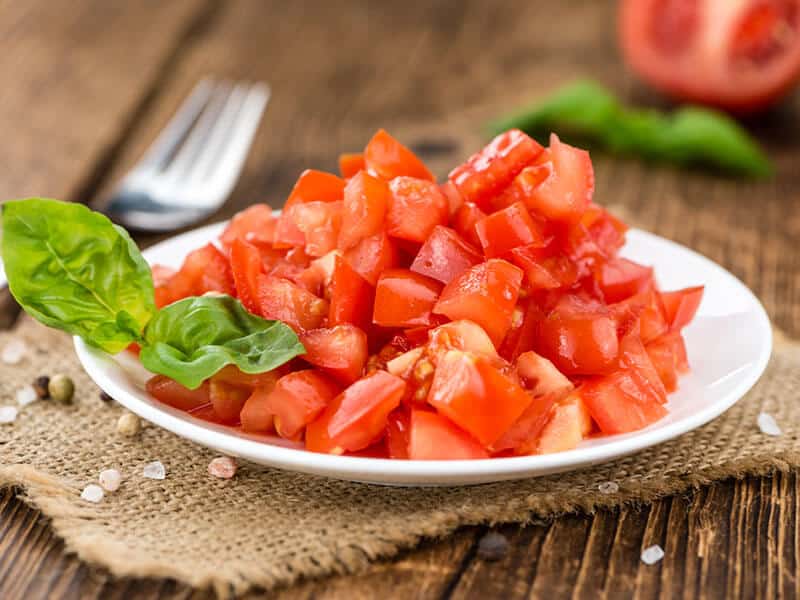
Diced tomatoes are quite similar to tomato puree in terms of flavor, as both of them are typically unseasoned. However, the biggest trade-off for using diced tomatoes as a tomato puree alternative comes from its chunky texture.
This can be either a good or a bad thing. If you like your dish to be a little chunky and chewy, then you may even prefer the bulky feel of diced tomatoes. Some recipes that suit diced tomatoes well are salsa, pasta, curry, and soup.
On the other hand, for dishes that require the smooth consistency of the puree, you’d better off choosing another alternative.
If you decide to go this route, use 2 cups of diced tomatoes for 1 cup of its pureed counterpart.
9. Roasted Tomatoes
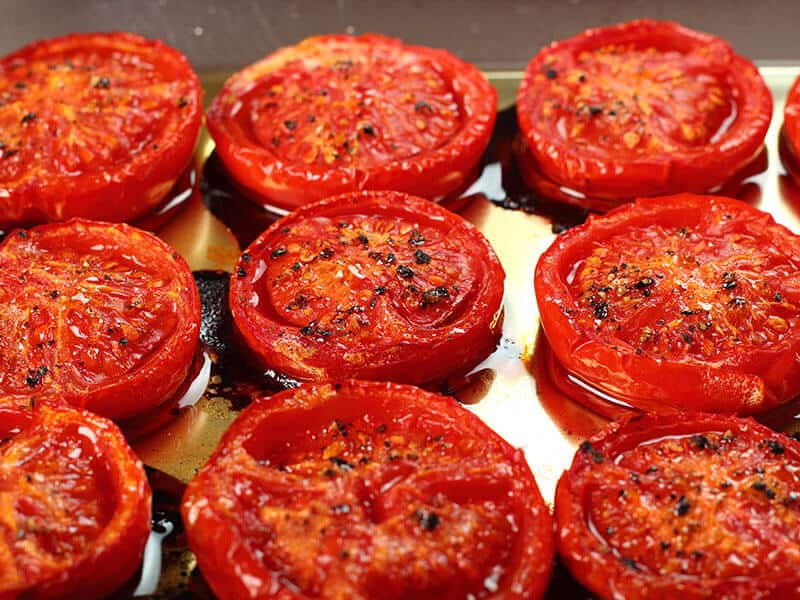
Another way to replace tomato puree is to blend your roasted tomatoes. Remember to add some olive oil and salt to the tomatoes before roasting them. After that, blend them with a blender for a smoky, deep flavored tomato puree alternative.
Any type of tomato will do the job; however, make sure that you use ripe tomatoes.
If you decide to go with the roasted tomato blend, you can use the same amount as the prepackaged puree type when cooking.
What about fresh tomatoes? Well, if you have some fresh, plump tomatoes at hand (and some free time too), you can actually make your own version of tomato puree. More on this in the next section!
You can see this video to know more:
10. Fish Sauce Or Worcestershire

If you haven’t noticed, all of the alternative suggestions listed above are, in one way or another, quite similar to tomato puree in terms of flavor. But what if you just can’t stand the taste of tomatoes? Well, if that’s the case, then these two condiments are what you need.
Admittedly, fish sauce and Worcestershire lack the defining sweetness of tomato puree and have a more overwhelming, “in-your-face” flavor. To use them as a tomato puree alternative, you’ll often need to mix them with water in order to tone down the taste a little bit.
However, both of them are comparable to the puree in the sense that they’re all specialized in adding an extra kick of flavor to the dish. In addition, these two condiments also work great as a base ingredient for many sauce recipes.
That said, it’s hard to pinpoint the exact substitute ratio for fish sauce and Worcestershire since their taste is remarkably different from that of the tomato puree. So it’s best that you adjust the amount accordingly based on your preference.
11. Vegemite

At first sight, vegemite seems to be an unlikely candidate for tomato puree because these two bear no resemblance in terms of taste. While tomato puree is sweet, tangy, and refreshing, vegemite is notorious for its bitter and unpleasant taste for a lot of people.
That said, vegemite is nearly identical to tomato puree when it comes to consistency and texture; thus making it a great tomato puree alternative when used as a spread or a base ingredient.
If you want to try this straight but effective substitute, simply replace tomato puree with vegemite in a 1:1 ratio.
Can’t bear the taste of vegemite? Maybe these 5 ways to enjoy them will change your mind.
12. Pumpkin Or Squash Puree
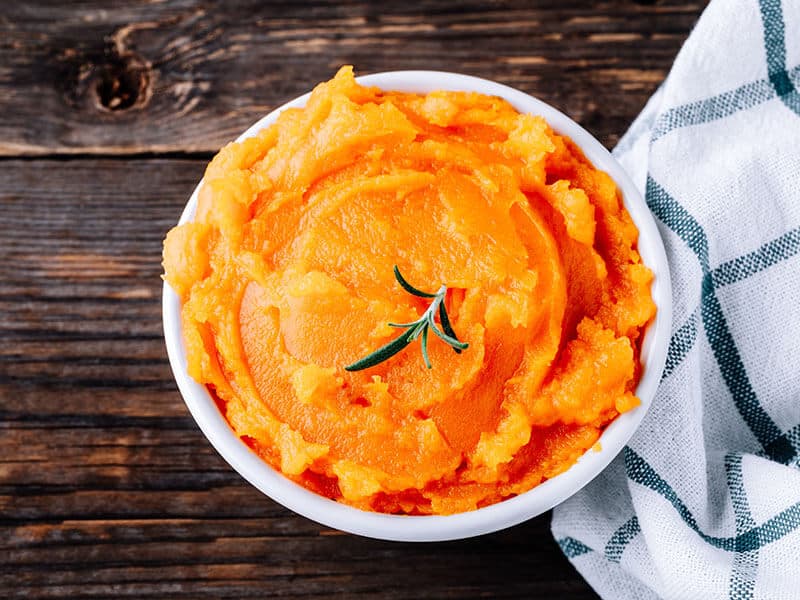
Another non-tomato substitute for tomato puree is pumpkin or squash puree.
The most noticeable difference between these two and tomato puree is their consistency, as both of them are quite dry in comparison. To fix this, simply add some water or oil the same way you would with tomato paste.
In terms of taste, you likely won’t find any real difference in most recipes as they will blend in perfectly with other flavors the same way the tomato puree would.
However, for dishes where tomato puree takes the main stage, it’s best to avoid using these in order not to drastically alter the flavor.
For pumpkin and squash puree, use 1 cup of either in place of 2 cups of tomato puree.
Simple Way To Make Your Own Tomato Puree
I know that people often buy their tomato puree in a supermarket or grocery store, and I do so all the time too. However, if you have some fresh tomatoes at hand, why don’t you give homemade tomato puree a try!
The only ingredients you’ll need are some fresh tomatoes with the help of a big pot and a blender.
Follow these steps to easily make your own tomato puree:
- Step 1: Use cold water to wash the tomatoes, then dry them by patting them with a clean towel.
- Step 2: Peel the tomatoes, then remove their cores
- Step 3: Remove the seeds and overly watery pulp
- Step 4: Chop your tomatoes
- Step 5: Place the tomatoes in a water-filled pot, then use medium-high heat to bring the water to a boil.
- Step 6: Turn the heat down to medium and simmer until the tomatoes become tender and let out their juices (about 10 minutes).
- Step 7: Take the tomatoes out of the pot and let them rest for 5-10 minutes.
- Step 8: Use a blender to puree the tomatoes until smooth.
For fresh, homemade tomato puree, 4 cups of tomatoes can be used to make 1 cup worth of tomato puree.
You can see this video to know more:
FAQs About Tomato Puree
These are the answers to some of the most frequently asked questions concerning tomato puree.
Think Twice Before Buying A New Can Of Tomato Puree
Now that you’ve known about these alternatives, you won’t have to rush out for a new can of tomato puree as soon as it runs out.
Although some of them might not taste exactly like the original puree, it’s not really a bad thing. Think of it as an opportunity to spice up your recipes; maybe you’ll find a new, unique taste that you enjoy!
Remember to try these options and let me know how it goes for you in the comment section. If you think that this post is helpful, don’t hesitate to press the like button and share it with your loved ones!
References
- Contributors to Wikimedia projects, (2004b). Tomato purée – Wikipedia.
- Nutrient content of tomatoes and tomato products – PubMed.

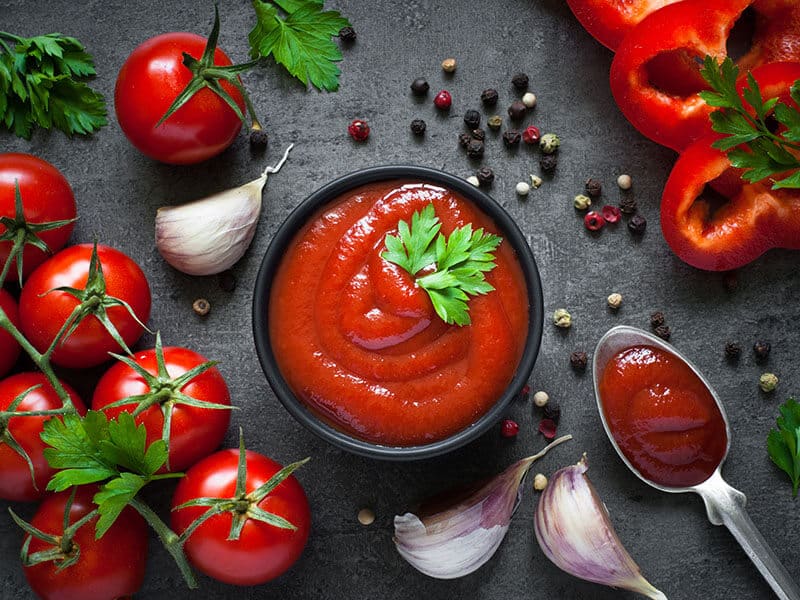
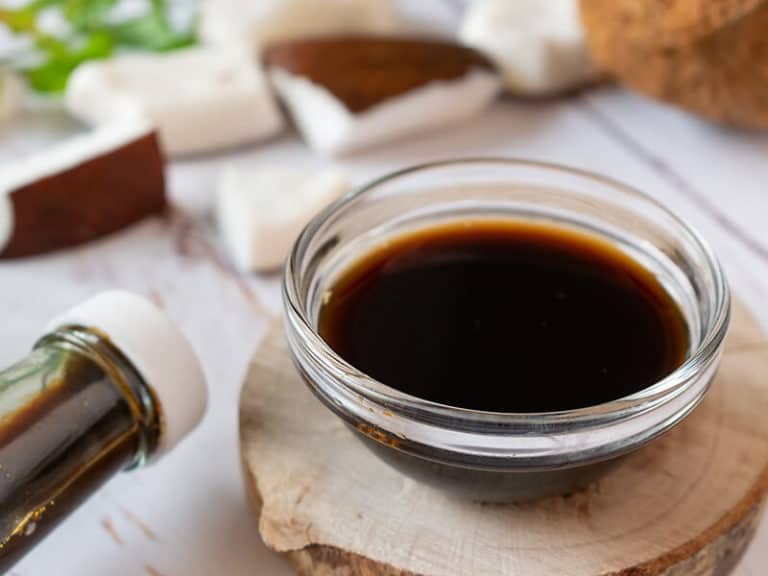



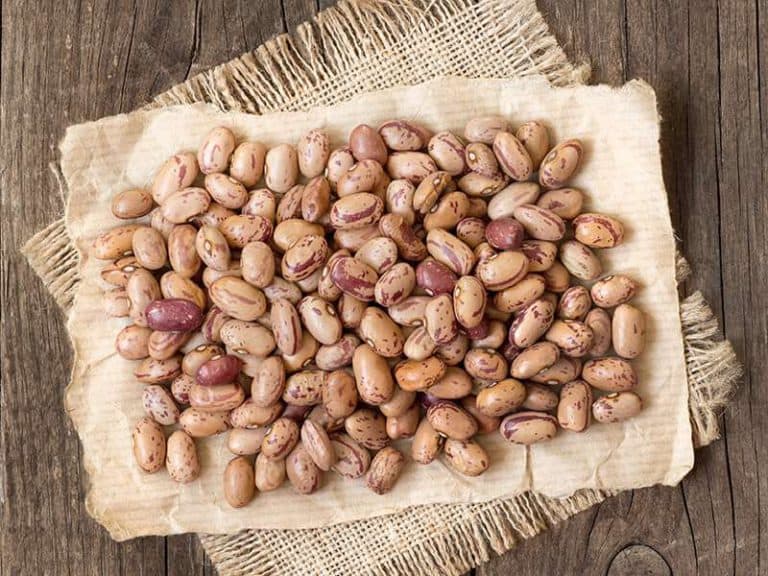
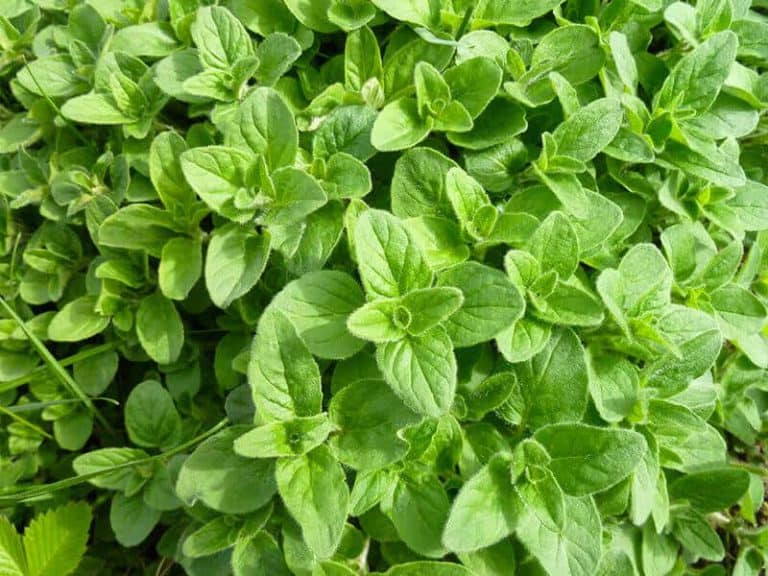
Amanda Collins
Founder and Senior Culinary Editor
Expertise
Culinary Arts and Management, Food Journalism and Critique, Recipe Development and Testing, Global Culinary Traditions, Sustainable Food Practices
Education
Institute of Culinary Education (ICE), New York, NY
Program: Diploma in Culinary Arts
Focus: Intensive hands-on training in culinary techniques, recipe development, and kitchen management, preparing students for professional roles in the culinary industry.
Monroe College, New Rochelle, NY
Program: Associate in Applied Science in Culinary Arts
Focus: Practical culinary skills, including cooking techniques, menu planning, and kitchen operations, with an emphasis on hands-on experience and industry standards.
Amanda Collins is a seasoned chef and food editor with a deep love for global flavors. Trained at the Institute of Culinary Education and Monroe College, and with over 15 years in the culinary field, Amanda has refined her skills in kitchens worldwide. Her background in food studies gives her a unique ability to share both recipes and the cultural stories that shape them.
As senior culinary editor at thebreslin.com, Amanda’s work brings authentic dishes to life, inviting readers to explore new flavors and techniques from around the globe. Her approachable style makes it easy for anyone to bring a bit of the world’s cuisine into their kitchen.